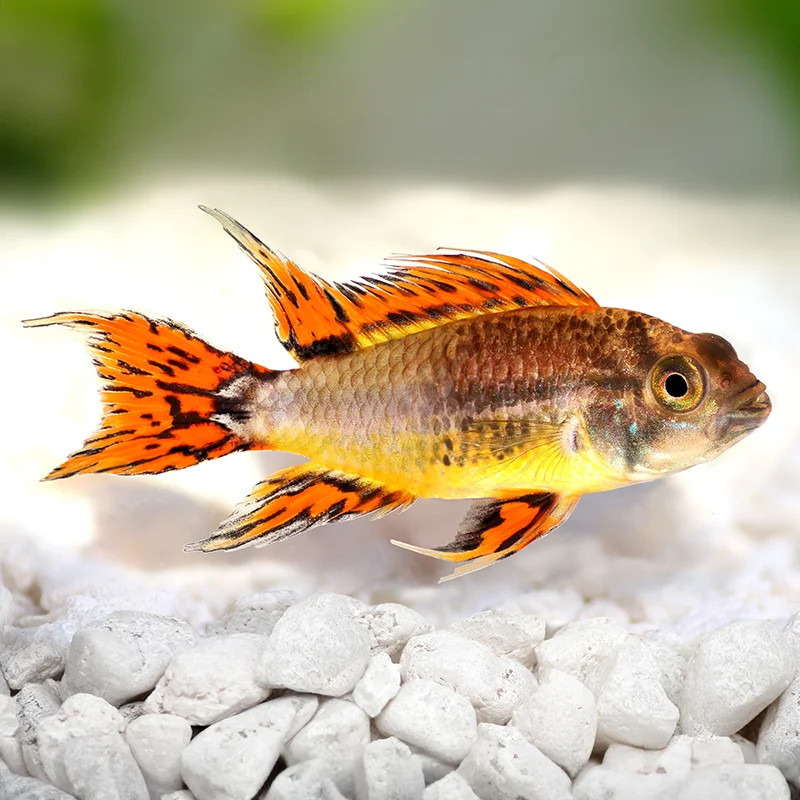Stocks Available
ELECTRIC BLUE JACK DEMPSEY
SKU:114777
CICHLASOMA OCTOFASCIATUM
1-2 INCH

Stock Available
Introduction: • Common Names: Dwarf Cockatoo Cichlid, Orange Flash Cockatoo • Natural Habitat: Native to the slow-moving waters of the Amazon Basin, particularly in regions with dense vegetation, where they inhabit areas with leaf litter and submerged roots. Physical Characteristics: • Appearance: Known for its vibrant orange and yellow coloration, with distinct blue and black markings. The dorsal fin is particularly prominent, resembling a crest, hence the name "Cockatoo." • Size: Typically grows up to 3-4 inches (7.5-10 cm) in length. • Lifespan: Average lifespan ranges from 3-5 years in a well-maintained aquarium. Habitat Requirements: • Tank Size: Minimum of 20 gallons for a pair; larger tanks are ideal for groups or mixed communities. • Water Conditions: o Temperature: Prefers warmer water, ideally between 75-82°F (24-28°C). o pH: Thrives in slightly acidic to neutral water, with a pH range of 6.0 to 7.5. • Aquascaping: Needs plenty of hiding spots, such as caves and dense plant cover, to feel secure and establish territories. Diet: • Primary Diet: Omnivorous; feeds on small invertebrates, insect larvae, and plant matter in the wild. • Supplemental Feeding: High-quality flake or pellet food, supplemented with live or frozen foods like daphnia, bloodworms, or brine shrimp. • Feeding Frequency: Feed small amounts 1-2 times daily, ensuring a varied diet for optimal health. Compatibility: • Temperament: Generally peaceful but can be territorial, especially during breeding. • Suitable Tank Mates: Compatible with other small, peaceful fish; avoid aggressive species or larger fish that may harass them. • Incompatibilities: Not suitable for aggressive or overly boisterous fish, which can stress the Dwarf Cockatoo. Care Level: • Difficulty: Moderate; requires stable water parameters and a well-planned environment. • Health Monitoring: Regularly observe for signs of stress, disease, or aggression, particularly during breeding periods. Breeding: • Breeding in Captivity: Possible with proper conditions; pairs can form strong bonds and engage in complex breeding behaviors. • Spawning: Egg layers; typically lay eggs in caves or flat surfaces, with both parents guarding the eggs and fry after hatching. Economic Considerations: • Market Demand: Popular among aquarium enthusiasts for their striking colors and engaging personalities. • Wholesale/Retail Pricing: Generally available at moderate prices, influenced by coloration and breeding success. Sustainability and Conservation: • Wild Population: Stable in most areas, but habitat destruction and water pollution can pose risks. • Aquaculture Efforts: Increasingly bred in captivity to meet market demands and alleviate pressure on wild populations. • Regulations: Adherence to local and international regulations is essential for sustainable practices. Conclusion: The Dwarf Cockatoo Cichlid (Orange Flash variant) is a colorful and engaging addition to community aquariums, prized for its beauty and unique behaviors. With appropriate care, these cichlids can thrive, providing joy to both novice and experienced aquarists. Their moderate care requirements and peaceful nature make them suitable for well-planned community setups.
Data sheet
16 other products in the same category: